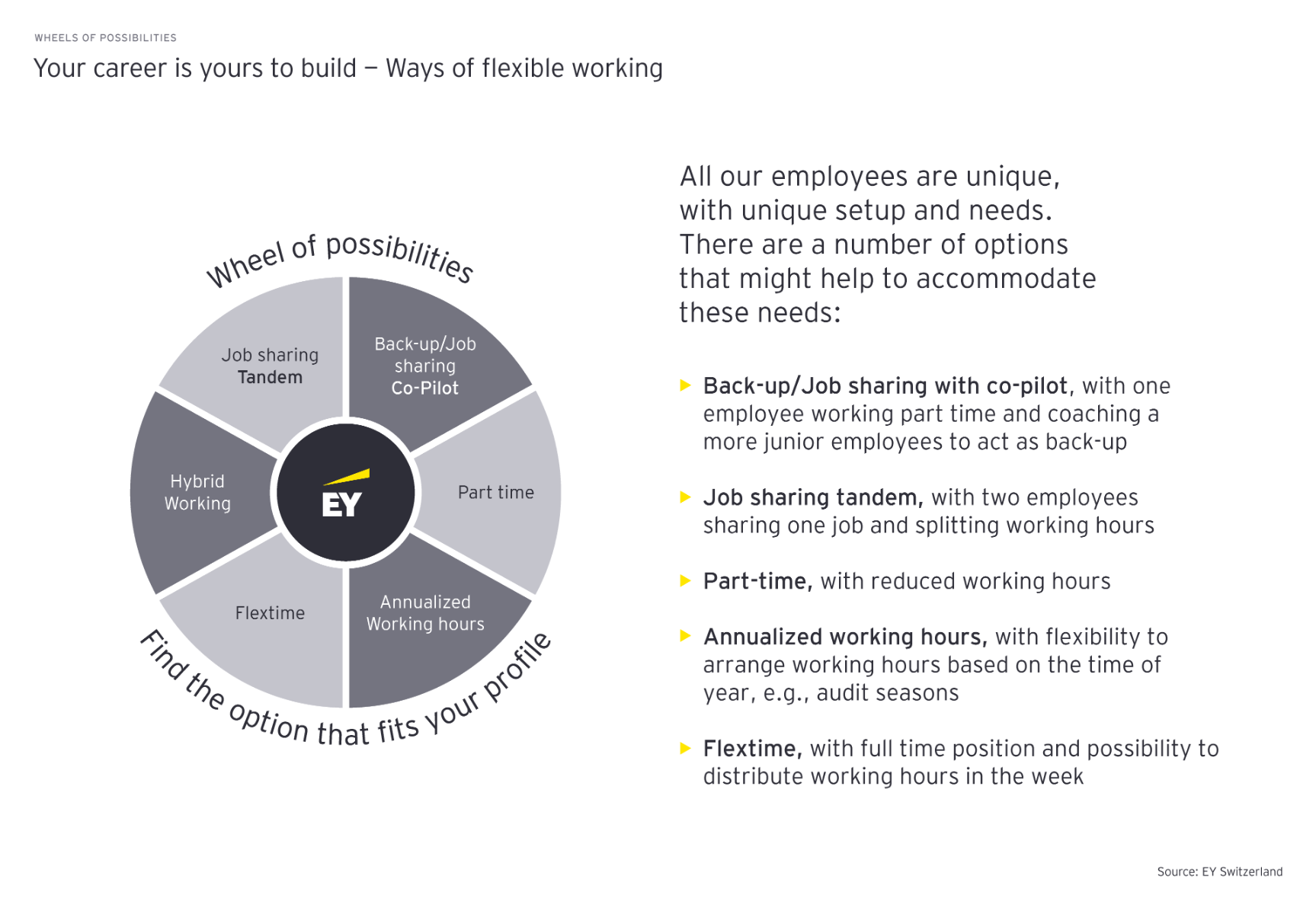EY refers to the global organization, and may refer to one or more, of the member firms of Ernst & Young Limited, each of which is a separate legal entity. Ernst & Young Limited is a Swiss company with registered seats in Switzerland providing services to clients in Switzerland.

EY has embarked on a transformative journey to create a culture of flexibility that caters to the unique circumstances of our workforce.
In brief
- Flexible working is a key driver of success but there are still challenges around mindset and acceptance.
- Available options need to accommodate the complexities and individuality of different situations.
- EY developed a structured three-step methodology to empower people to shape their own work-life balance.
In today’s evolving workplace, flexibility has become more than just a desirable perk – it is now a critical business imperative. At EY, we deeply understand and appreciate the diverse values, needs and aspirations of our current and future employees, as well as the increasing blurring of boundaries between personal and professional lives. In this article – inspired by our contribution to the Gender Intelligence Report 2023 – we share how we’re responding to these changes and driving a paradigm shift. In doing so, we hope to encourage others in the consulting industry – and beyond – to embrace more flexible practices.
Hearing directly from our people who work flexibly and achieve high performance proved to be incredibly powerful.
Margit Vunder
Associate Director, Diversity & Inclusion project lead | EY Switzerland
We were determined to make flexible working a reality and seamlessly integrate it into our organizational practices.
A dedicated project team began by presenting an official business case to our executive leadership team. This comprehensive presentation included data-driven insights on the current situation, an explanation of the benefits associated with the desired state, and compelling stories shared by employees who had embraced flexible working arrangements. Hearing directly from our people who work flexibly and achieve high performance proved to be incredibly powerful. It helped our leaders recognize the mutual gains in meeting both performance and work-life needs and allowed them to see that flexibility is possible even in demanding roles. This connection got us the support and engagement from the leadership team.
As part of the process, we delved deeper into the complexities and individuality of different situations to ensure that our solution would meet the needs of our people and the business. Through personas and focus group conversations with people from different departments, ranks, generations and work arrangements, we uncovered key findings that shaped our approach:
Acknowledging the diverse needs for flexibility, we devised a structured three-step methodology to empower our people to shape their own work-life balance. This approach focuses on three key aspects to be considered in the decision-making process: self-reflection, business needs and solution ideation.
In a first step, employees assess their values, goals and career aspirations, empowering them to make informed decisions. It is crucial for women to be well-informed when considering reducing their working hours, as it has predominantly been women who opt for part-time work due to factors like lower wages, societal expectations, expensive childcare, and lack of individual taxation.
However, they may not fully realize the long-term implications, such as the gender pension gap and an annual retirement income that is on average CHF 20,000 lower, as highlighted by the recent Swiss Life Gender Pension Gap study, with divorced women being particularly affected. Raising awareness among women is essential, and EY plays a vital role in guiding and providing information as an employer.
Next, employees analyze their specific role, assessing the flexibility and constraints involved. Focusing on the different types of work involved – like concentrated individual work, routine transaction processing and teamwork – can help create a clearer picture of the potential for flexibility. Ultimately, this exercise provides a deeper understanding of the actual requirements from both the business and client perspectives.

With more clarity on their own requirements and business needs, the employee can propose a flexible package drawing on elements from EY’s wheel of possibilities. Our “How to make it work guide” directs employees and their managers, as the first step, to explore together potential solutions that accommodate the needs of all parties involved.
Flexibility concerns everyone, whether as an employee on a flexible working arrangement, as their manager, or simply as a colleague. All have a responsibility to make it work. To foster engagement and commitment, we harnessed the power of storytelling. By sharing inspiring stories of employees who have thrived with flexible work arrangements, we created empathy, fostered understanding, and motivated leaders, managers, and employees to embrace this cultural shift. The data derived from our people pulse survey and the endorsement of New Work concepts further solidified the business case for flexibility.
Download the Gender Intelligence Report 2023
Summary
A paradigm shift is needed to afford employees the flexibility they need to meet their unique needs. Looking ahead, we remain committed to building an inclusive work environment that acknowledges the unique starting points, identities, experiences, and needs of our employees. By fostering engagement, leveraging storytelling, and continuously learning and adapting, we take pride in having accomplished this important step in creating a culture that values and embraces flexibility as a key driver of success.



